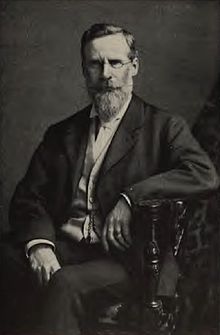威廉·克鲁克斯
| 威廉·克鲁克斯 爵士 Sir William Crookes | |
|---|---|
 | |
| 出生 | 1832年6月17日 |
| 逝世 | 1919年4月4日(86岁) |
| 国籍 | 英国 |
| 知名于 | 发现铊元素、发明辐射计、克鲁克斯管 |
| 奖项 | 皇家奖章(1875年) 戴维奖章(1888年) 阿尔伯特奖章(1899年) 科普利奖章(1904年) 艾略特·克雷松奖章(1912年) |
| 科学生涯 | |
| 研究领域 | 物理化学 |
威廉·克鲁克斯爵士,OM,FRS(英语:Sir William Crookes,1832年6月17日—1919年4月4日),英国物理学家、化学家,参与皇家化学学院,致力于光谱学研究。
威廉·克鲁克斯于1859年创办并主编《化学新闻》。1863年当选英国皇家学会院士,1913年至1915年间担任皇家学会会长。是铊元素的发现和命名者,以及真空管研究先驱。其1874年研制的阴极射线管(克鲁克斯管),为1895年X射线的发现和1897年电子的发现提供了基本实验条件。他同时也发明闪烁镜等实验仪器和防护游离辐射的特种玻璃,研究稀土元素及其光谱、空气中固氮等问题,并以此在1873年发明了辐射计(克鲁克斯辐射计)[1]。
生平[编辑]
早年[编辑]
威廉·克鲁克斯出生于伦敦,有15个弟妹。他的父亲约瑟夫·克罗克斯(Joseph Crookes)是北方出身的裁缝,当时和他第二任妻子玛丽·斯科特(Mary Scott Lewis Rutherford Johnson)住在一起。
1850年至1854年,他担任了大学的助理职位,很快开始原创性的工作。他没有走向他的老师冯·霍夫曼的有机化学领域,而是研究新的硒化合物,这成为他1851年首次发表论文的主题。之后1854年他在牛津的雷德克里夫天文台与曼努埃尔·约翰逊一起工作,在那里他将最新的蜡纸摄影技术与弗朗西斯·罗纳兹制造的机器相结合,可以连续记录气象数据[2]。 1855年,他被任命为切斯特大学的化学讲师。
1856年,他与达伦顿威廉·汉弗莱(William Humphrey of Darlington)的女儿艾伦(Ellen)结婚,有三个儿子和一个女儿,生活在伦敦。1859年,创办了《化学新闻》。这本杂志是他编辑多年的科学杂志,不过规模小于当时一般主流科学期刊。
中年[编辑]
克鲁克斯在实验上有众多成果。他以极大的热情接受本生和古斯塔夫·基尔霍夫介绍的光谱分析方法。1861年,他发现一个过去未知的元素,光谱中有一明亮的绿色发射谱线,因此取希腊语“θαλλός”(thallos)—“绿芽”之意,命名为元素铊(thallium)。 这项工作使他的名声确立,1863年当选为英国皇家学会院士。1871年他也在《化学分析选择方法》上发表论文。
克鲁克斯是建造和使用真空管来研究物理现象的先驱[3]。1874年他开发了克鲁克斯管[4],研究阴极射线,发表了许多关于光谱学的论文,并对其中各个子领域进行研究。他在低压气体导电研究中发现,随着压力的降低,负极(阴极)似乎会发出光线(即所谓的“阴极射线”,现在已知是一股自由电子流,并可用于映像管)。因此,他也可以说是第一批研究后来所谓等离子的科学家之一,并在1879年认为这是第四种物质状态[5]。他还设计了闪烁镜,是最初几种研究核放射性的方法之一。
克鲁克斯研究阴极射线的性质,表明它们以直线行进,当它们落在某些物质上时会引起荧光,并且可以产生很大的热量。他因此相信他发现了第四种物质状态,他称之为“辐射质”(Radiant Matter)[6]。他认为光线由一般分子量级的粒子流组成。后来约瑟夫·汤姆森也类似这样解释阴极射线的亚原子性质(由负电子流组成)。虽然之后不久克鲁克斯的“辐射质”理论观点被取代[7],他在此领域的实验工作是许多发现的基础,并最终改变了整个化学和物理学。
在研究铊元素的过程中,他注意到真空平衡。 他很快就发现了一种驱动克鲁克斯辐射计的现象,当暴露于辐射能量时,克鲁克斯辐射计的叶片暗面会离开辐射源,亮面会靠近辐射源而转动。然而,克鲁克斯没有提出这种明显“辐射引起的吸力和斥力”的真正解释。
1880年后,他住在肯辛顿公园花园(Kensington Park Gardens)的私人实验室里,完成他所有的后期工作。
晚年[编辑]
克鲁克斯在1895年确定了第一个已知的氦样品。1897年被封为爵士。1903年,克鲁克斯把注意力转移到新发现的放射性现像,实现了铀元素与其放射性衰变产物“铀-X”(后来被确定为镤元素)的分离。 他观察到分离衰变产物的逐渐衰减,以及原始铀中同时有新鲜的供应。 在这个重要发现的同时,他也观察到当放射性活性物质中放射出的“p粒子”撞击到硫化锌时,每次冲击都伴随着微小的闪烁,这种现象成为了日后放射性技术中最有用的方法之一。
心灵论[编辑]

1860年代后期,可能因为克鲁克斯的一个弟弟在21岁时死于黄热病[8][9],克鲁克斯开始对心灵论论感兴趣。1867年,受到瓦利(Crickwell Fleetwood Varley)的影响,克鲁克斯出席了一次降神会,试图与他的兄弟联系 [10][11]。在1871年至1874年间,克鲁克斯与当时的灵媒凯特·福克斯,佛罗伦萨·库克和丹尼尔·东拉斯·亨姆合作了一些研究。经过调查,他认为这些灵媒可能产生真正的超常现象,并与精神交流[12][13]。但后来的心理学家Leonard Zusne和Warren H. Jones则认为克鲁克斯非常可笑,把诈欺的灵媒当成是真实的[14]。科学史学家Sherrie Lynne Lyons也认为克鲁克斯是被欺骗的[15]。
克鲁克斯后来加入了心灵现象研究学会,成为1890年代的会长,他也加入了神智学协会和灵魂俱乐部[8]。1890年,他开始进入黄金黎明协会[16]。
参考资料[编辑]
- ^ 美国专利第182,172号, Improvement In Apparatus For Indicating The Intensity Of Radiation
- ^ Ronalds, B.F. Sir Francis Ronalds: Father of the Electric Telegraph. London: Imperial College Press. 2016. ISBN 978-1-78326-917-4.
- ^ Alexander E. Outerbridge, Jr., A Fourth State of Matter. Lecture delivered before the Franklin Institute, 17 February 1881. Journal of the Franklin Institute of the State of Pennsylvania, Volume 81. By Franklin Institute (Philadelphia, Pa.). Page 287+ (页面存档备份,存于互联网档案馆).
- ^ The difference between "Crookes tubes" and "Geissler tubes" is this: In a Geissler tube the exhaustion is very much less than in a Crookes tube, the light which we see in the Geissler tube being due to the luminescence of the residual gas. (Transactions, Volume 9. Hertfordshire Natural History Society and Field Club. The Club, 1898. Page 136 (页面存档备份,存于互联网档案馆).)
- ^ William Crookes, On Radiant Matter. Lecture delivered before the British Association for the Advancement of Science, at Sheffield, Friday, 22 August 1879. The Popular Science Monthly, Volume 16. D. Appleton, 1880. Pg157+ (页面存档备份,存于互联网档案馆)
- ^ Radio-activity induced by the oscillatory discharge, or, The subsequent radio-active emanation from substances exposed to the Tesla oscillatory discharge. Harry Marshall Diemer, Ralph Stuart Cooper. Cornell University, 1903. Page 43+ (页面存档备份,存于互联网档案馆).
- ^ Chemist & Druggist, Volume 60. Benn Brothers., 1902. Pg 268 (页面存档备份,存于互联网档案馆).
- ^ 8.0 8.1 Janet Oppenheim. (1988). The Other World: Spiritualism and Psychical Research in England, 1850-1914. Cambridge University Press. pp. 343–347. ISBN 978-0521265058
- ^ John Hannavy. (2007). Encyclopedia of Nineteenth-Century Photography. Routledge. p. 350. ISBN 978-0415972352 "Crookes' beloved younger brother had died in 1867 and the scientist hoped that spiritualism could provide a reunion. Although warned of the risk of ridicule, Crookes announced his intent to investigate mediums."
- ^ Sherrie Lynne Lyons. (2010). Species, Serpents, Spirits, and Skulls: Science at the Margins in the Victorian Age. State University of New York Press. p. 92. ISBN 978-1438427980 "Crookes appears to have been initially attracted to spiritualism when his youngest brother, whom he was quite close to, died of yellow fever. Brought up with the traditional Christian belief in the afterlife, Crookes was persuaded to attend a séance in 1867 to try to make contact with his brother."
- ^ Martyn Jolly. (2006). Faces of the Living dead: The Belief in Spirit Photography. Miegunyah Press. p. 30. ISBN 978-0712348997 "In 1867, he was devastated by the death of his much-loved youngest brother who, at the age of twenty-one. had caught yellow fever while laying a submarine telegraph cable in Cuba. At the time, Crookes was collaborating with a fellow electro-physicist Cromwell Fleetwood Varley, who was a pioneer of intercontinental telegraphy, as well as a clairvoyant. He persuaded Crookes to try to get in touch with his dead brother by spiritualist means."
- ^ Daniel Cohen. (1971). Masters of the Occult. Dodd, Mead & Company. p. 111. ISBN 978-0396064077
- ^ Andrew Neher. (2011). Paranormal and Transcendental Experience: A Psychological Examination. Dover Publications. p. 214. ISBN 978-0486261676 "William Crookes, the noted English physicist, had endorsed Catherine Fox as genuine... Crookes also endorsed several other mediums who were later exposed, including Anna Eva Fay (who was exposed more than once and who eventually explained how she duped Crookes), Florence Cook (who was the subject of more than one expose), and D. D. Home."
- ^ Leonard Zusne; Warren H. Jones. (2014). Anomalistic Psychology: A Study of Magical Thinking. Psychology Press. p. 216. ISBN 978-0-805-80508-6 "The fact is that William Crookes, although very good at physics experiments, was rather weak on drawing inferences and on theorizing. Besides, he was gullible. He endorsed several mediums in spite of their demonstrated trickery. Having witnessed a single seance with Kate Fox, he became convinced that the Fox sisters' rappings were genuine."
- ^ Sherrie Lynne Lyons. (2010). Species, Serpents, Spirits, and Skulls: Science at the Margins in the Victorian Age. State University of New York Press. p. 101. ISBN 978-1438427980
- ^ Alex Owen. The Place of Enchantment: British Occultism and the Culture of the Modern. Chicago: University of Chicago Press. 2007: 70.
| |||||||||||||||||||||||||||
| |||||||||||||||||||||||||||||||||||||||||||||||||||||||||||||||||||||||||||||||||||||||
| ||||||||||||||||||||||||||||||||
| ||||||||||||||||||||||||||||||||
